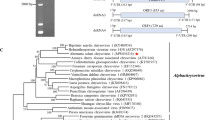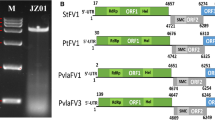Abstract
Corynespora cassiicola is an important phytopathogenic fungus that severely impairs crop production. Here, we report the molecular characterization of a novel positive-sense single-stranded RNA (+ssRNA) mycovirus, Corynespora cassiicola fusarivirus 1 (CcFV1), isolated from C. cassiicola strain 20200826-3-1. Excluding the poly(A) tail, the genome of the virus is 6491 nt in length and contains three putative open reading frames (ORFs). The large ORF1 encodes a polypeptide of 1524 aa with a conserved RNA-dependent RNA polymerase (RdRp) domain and a helicase (Hel) domain. BLASTp analysis showed that CcFV1 ORF1 has the highest similarity to Setosphaeria turcica fusarivirus 1 (StFV1, 50.45% identity, E-value 0.0). ORF2 encodes a polypeptide with a conserved chromosome segregation ATPase (Smc) domain. The smaller ORF3 encodes a polypeptide with an unknown function. Phylogenetic analysis based on the ORF1- encoded polypeptide showed that CcFV1 is phylogenetically related to members of the newly proposed family "Fusariviridae". Thus, we suggest that CcFV1 might be a novel member of the family "Fusariviridae", and is the first to be discovered in C. cassiicola.

Similar content being viewed by others
References
Ghabrial SA, Castón JR, Jiang D et al (2015) 50-plus years of fungal viruses. Virology 479–480:356–368. https://doi.org/10.1016/j.virol.2015.02.034
Yu X, Li B, Fu Y et al (2010) A geminivirus-related DNA mycovirus that confers hypovirulence to a plant pathogenic fungus. Proc Natl Acad Sci 107:8387 LP-8392 LP. https://doi.org/10.1073/pnas.0913535107
Liu L, Xie J, Cheng J et al (2014) Fungal negative-stranded RNA virus that is related to bornaviruses and nyaviruses. Proc Natl Acad Sci 111:12205 LP-12210 LP. https://doi.org/10.1073/pnas.1401786111
Zhang R, Liu S, Chiba S et al (2014) A novel single-stranded RNA virus isolated from a phytopathogenic filamentous fungus, Rosellinia necatrix, with similarity to hypo-like viruses. Front Microbiol 5:1–12. https://doi.org/10.3389/fmicb.2014.00360
Kwon SJ, Lim WS, Park SH et al (2009) Erratum: Molecular characterization of a dsRNA mycovirus, Fusarium graminearum virus-DK21, which is phylogenetically related to hypoviruses but has a genome organization and gene expression strategy resembling those of plant potex-like viruses. Mol Cells 28:73–74. https://doi.org/10.1007/s10059-009-0112-1
Zhong J, Zhao SQ, Li GF et al (2016) A novel fusarivirus isolated from the phytopathogenic fungus Nigrospora oryzae. Virus Genes 52:891–895. https://doi.org/10.1007/s11262-016-1371-5
Marais A, Nivault A, Faure C et al (2018) Molecular characterization of a novel fusarivirus infecting the plant-pathogenic fungus Neofusicoccum luteum. Arch Virol 163:559–562. https://doi.org/10.1007/s00705-017-3620-x
Liu W, Hai D, Mu F et al (2020) Molecular characterization of a novel fusarivirus infecting the plant-pathogenic fungus Botryosphaeria dothidea. Arch Virol 165:1033–1037. https://doi.org/10.1007/s00705-020-04554-1
Gao Z, Cai L, Liu M et al (2021) A novel previously undescribed fusarivirus from the phytopathogenic fungus Setosphaeria turcica. Arch Virol 166:665–669. https://doi.org/10.1007/s00705-021-04954-x
Gong W, Liu H, Zhu X et al (2021) Molecular characterization of a novel fusarivirus infecting the plant-pathogenic fungus Alternaria solani. Arch Virol 166:2063–2067. https://doi.org/10.1007/s00705-021-05105-y
Li X, Sui K, Xie J et al (2020) Molecular characterization of a novel fusarivirus infecting the edible fungus Auricularia heimuer. Arch Virol 165:2689–2693. https://doi.org/10.1007/s00705-020-04781-6
Silva WPK, Wijesundera RLC, Karunanayake EH et al (2000) New hosts of Corynespora cassiicola in Sri Lanka. Plant Dis 84:202. https://doi.org/10.1094/pdis.2000.84.2.202d
Madriz-Ordeana K, Jrgensen HJL, Nielsen KL, Thordal-Christensen H (2016) First report of Kalanchoe leaf and stem spot caused by Corynespora cassiicola in Denmark. Plant Dis 101(101):505–505. https://doi.org/10.1094/PDIS-08-16-1173-PDN
Carris LM, Glawe DA, Gray LE (1986) Isolation of the soybean pathogens Corynespora cassiicola and Phialophora gregata from cysts of Heterodera glycines in Illinois. Mycologia 78:503–506
Sato R, Kitazawa K (1980) Occurrence of soybean root rot caused by Corynespora cassiicola (Berk. & Curt.) Wei in Hokkaido. Jpn J Phytopathol 46:193–199
Dixon LJ, Schlub RL, Pernezny K, Datnoff LE (2009) Host specialization and phylogenetic diversity of Corynespora cassiicola. Phytopathology 99:1015–1027. https://doi.org/10.1094/PHYTO-99-9-1015
Kusakari S, Okada K, Nakasone W, Tanaka Y (2009) Corynespora leaf spot of Perilla (Perilla frutescens Britt.) caused by Corynespora cassiicola (Berk. & Curt.)Wei. Jpn J Phytopathol 57:737–740
Yan XX, Yu CP, Fu XA et al (2016) CARD9 mutation linked to Corynespora cassiicola infection in a Chinese patient. Br J Dermatol 174:176–179. https://doi.org/10.1111/bjd.14082
Smith LJOY (2008) Host range, phylogenetic, and pathogenic diversity of Corynespora cassiicola (Berk. & Curt.) Wei. Ph.D. dissertations, University of Florida, Gainesville, Florida, USA
Wang Y, Zhao H, Xue C et al (2020) Complete genome sequence of a novel mycovirus isolated from the phytopathogenic fungus Corynespora cassiicola in China. Arch Virol 165:2401–2404. https://doi.org/10.1007/s00705-020-04723-2
Huang X, Madan A (1999) CAP3: a DNA sequence assembly program. Genome Res 9:868–877. https://doi.org/10.1101/gr.9.9.868
Thompson JD, Gibson TJ, Plewniak F et al (1997) The CLUSTAL_X windows interface: flexible strategies for multiple sequence alignment aided by quality analysis tools. Nucleic Acids Res 25:4876–4882. https://doi.org/10.1093/nar/25.24.4876
Kumar S, Stecher G, Tamura K (2016) MEGA7: Molecular Evolutionary Genetics Analysis Version 7.0 for bigger datasets. Mol Biol Evol 33:1870–1874. https://doi.org/10.1093/molbev/msw054
Gasteiger E, Hoogland C, Gattiker A et al (2005) Protein identification and analysis tools on the ExPASy server. Proteom Protoc Handb. https://doi.org/10.1385/1592598900
Liu W, Xie Y, Ma J et al (2015) IBS: an illustrator for the presentation and visualization of biological sequences. Bioinformatics 31:3359–3361. https://doi.org/10.1093/bioinformatics/btv362
Acknowledgments
We are extremely grateful to Dr. Jing Wang for her valuable suggestions and help with sequence analysis.
Funding
This work was supported by the China Agriculture Research System of MOF and MARA [Grant number CARS-14] and the Key Project of Science and Technology of Henan Province [Grant number 201300110600].
Author information
Authors and Affiliations
Corresponding authors
Ethics declarations
Conflict of interest
All authors declare that they have no conflicts of interest.
Ethical approval
This article does not contain any studies with human participants or animals performed by any of the authors.
Additional information
Handling Editor: Zhongjie Shi.
Publisher's Note
Springer Nature remains neutral with regard to jurisdictional claims in published maps and institutional affiliations.
Supplementary Information
Below is the link to the electronic supplementary material.
Rights and permissions
About this article
Cite this article
Liu, M., Liu, X., Zhao, H. et al. Complete genome sequence of a novel fusarivirus from the phytopathogenic fungus Corynespora cassiicola. Arch Virol 167, 1375–1379 (2022). https://doi.org/10.1007/s00705-022-05428-4
Received:
Accepted:
Published:
Issue Date:
DOI: https://doi.org/10.1007/s00705-022-05428-4




